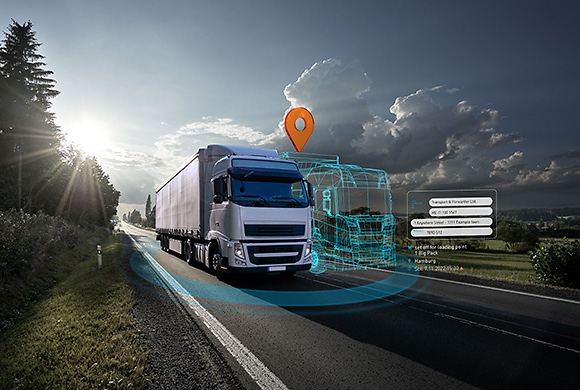Exchanging pallets in the transport and logistics industry – Do’s and Don’ts

When goods are delivered to a customer, they are handed over together with the right number of pallets needed to transport them. In return, the lorry driver also takes back the same number of pallets they have just dropped off, so as to maintain the European pallet pool. Sounds perfectly simple, doesn’t it? But as is so often the case, the truth looks a little different. We reveal the potential problems you might encounter when exchanging pallets and give you some useful tips on how to avoid them.
No logistics without pallets
Ahh, the good old pallet – indispensable when it comes to transporting and storing goods. The classic wooden pallet is often the image that springs to mind when you mention the word – we have the Euro pallet furniture trend to thank for that. And indeed, the best-known version is the wooden pallet standardised by the European Pallet Association (EPAL), which can be recognised by the EUR and EPAL branding proudly emblazoned on its exterior. This sturdy crate usually measures 120 cm in length, 80 cm in width and can carry up to 1.5 tonnes in weight.
But the well-known wooden pallets aren’t alone – there are also plastic models that are particularly popular in other European countries. Logistics companies in Germany, however, usually prefer to stick to the classic, with the wooden pallet being the undisputed favourite when it comes to goods transport. These come in three conditions: ‘new’, ‘as new’ and ‘used but still fully exchangeable’. If a Euro pallet has suffered some minor damage, then it can be taken to special EPAL-licensed companies that will refurbish it. Heavily damaged pallets, meanwhile, are removed from the exchange pool altogether.
Looking for more tips and tricks for transport companies?
Why is the pallet exchange so important?
Transporting goods on pallets ensures that the manufactured goods reach their destinations safely and undamaged. The process looks like this: An empty lorry containing empty pallets drives to a loading point where it exchanges the empty pallets for full ones. These are then transported to the agreed unloading point. Then the same thing happens again. The lorry driver unloads the full pallets and swaps them for empty ones in return. And so the cycle continues. The principle is designed to ensure that there is always a sufficient number of pallets available.
But here’s the catch – the pallet cycle isn’t always as simple as it may appear to be at first glance. We have collected the three biggest challenges for you:
The question of quality – who decides whether a pallet is in good enough condition to be exchanged?
Generally speaking, pallets may only be exchanged if they come with their pallet note. This note is where the driver and the recipient record how many pallets are to be exchanged on site. But watch out: not every pallet can be exchanged. Only pallets that are in ‘new’, ‘as new’ or ‘used’ condition are allowed to be exchanged. But who has the final say on the quality of a pallet? It’s up to the driver and the recipient to decide.
However, this isn’t always plain sailing – for instance, the recipient might reject an empty pallet because they think it’s unusable, but the driver disagrees. In this situation, the only thing the recipient can do is insist that the driver brings a pallet in acceptable condition with them next time. The driver is now in what’s known as ‘pallet debt’.
The question of quantity: how many pallets does the lorry driver need to hand in?
A common problem that disrupts an otherwise smooth transport is that the lorry driver has to carry enough empty pallets along with their load. Some recipients exchange pallets when they receive their goods, some don’t – it can vary from customer to customer. If the driver doesn’t bring any empty pallets to the exchange – for instance, because they didn’t receive any at the previous unloading point – they enter pallet debt. The driver is then committed to delivering these pallets at a later point in time. This means extra work for the transport process.
A question of communication: how many pallets can the lorry driver actually take with them?
The exchange principle states that a lorry driver should also take pallets back with them after making their delivery. However, there are often problems at the loading point, as the recipient either fails to hand over any pallets at all to the driver, gives them the wrong number of pallets or even gives them damaged ones. This means that the issue has to be documented on the pallet note and clarified later. Even when the number and quality of the pallets given back is correct, time at the ramp is often so scarce that the person receiving the pallets simply throws them into the lorry. This can also lead to incorrect information being entered on to the pallet note.
The future of the pallet exchange
Manually exchanging pallets can sometimes be a laborious task – and one that can make the supply chain more susceptible to error. But all hope is not lost. The future of the pallet exchange process lies in digitalisation, similar to many other areas of the supply chain. The German Federal Ministry for Transport and Digital Infrastructure (Bundesministerium für Verkehr und digitale Infrastruktur, BMVI) has launched an extensive research project called ‘Silicon Economy’ to drive this change. A Fraunhofer IML spin-off company has developed an app-based cloud platform for pallet management. This innovative solution uses artificial intelligence to connect and manage every person and company involved along the value chain using an e-pallet note. The exchange process is digitally recorded, providing transparency for both sides at all times. Even pallet debts are automatically documented and stored in the relevant accounts all while complying with the applicable legislation. Systems from companies such as TIMOCOM Partner inter.PAL give drivers the power to digitalise their pallet management, thus making it easier for them. Pallets are input digitally, and the agreement with the recipient of the goods also takes place digitally, saving time and avoiding errors.
Sound right up your street? Then start testing TIMOCOM today!

Marie-Luise Neas
Marketing Communications Manager
